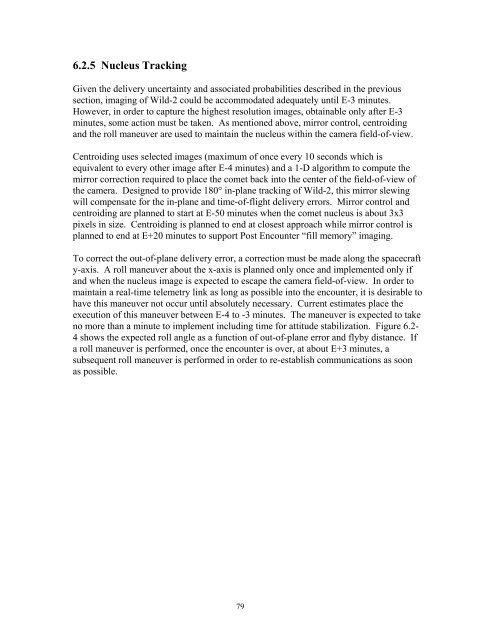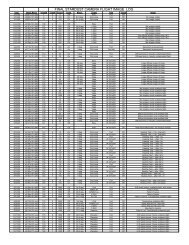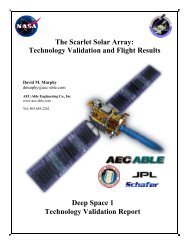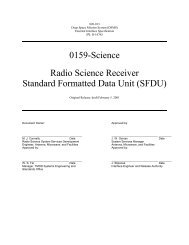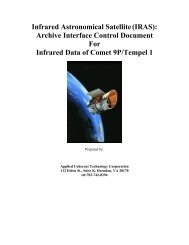MISSION PLAN - PDS Small Bodies Node
MISSION PLAN - PDS Small Bodies Node
MISSION PLAN - PDS Small Bodies Node
Create successful ePaper yourself
Turn your PDF publications into a flip-book with our unique Google optimized e-Paper software.
6.2.5 Nucleus Tracking<br />
Given the delivery uncertainty and associated probabilities described in the previous<br />
section, imaging of Wild-2 could be accommodated adequately until E-3 minutes.<br />
However, in order to capture the highest resolution images, obtainable only after E-3<br />
minutes, some action must be taken. As mentioned above, mirror control, centroiding<br />
and the roll maneuver are used to maintain the nucleus within the camera field-of-view.<br />
Centroiding uses selected images (maximum of once every 10 seconds which is<br />
equivalent to every other image after E-4 minutes) and a 1-D algorithm to compute the<br />
mirror correction required to place the comet back into the center of the field-of-view of<br />
the camera. Designed to provide 180° in-plane tracking of Wild-2, this mirror slewing<br />
will compensate for the in-plane and time-of-flight delivery errors. Mirror control and<br />
centroiding are planned to start at E-50 minutes when the comet nucleus is about 3x3<br />
pixels in size. Centroiding is planned to end at closest approach while mirror control is<br />
planned to end at E+20 minutes to support Post Encounter “fill memory” imaging.<br />
To correct the out-of-plane delivery error, a correction must be made along the spacecraft<br />
y-axis. A roll maneuver about the x-axis is planned only once and implemented only if<br />
and when the nucleus image is expected to escape the camera field-of-view. In order to<br />
maintain a real-time telemetry link as long as possible into the encounter, it is desirable to<br />
have this maneuver not occur until absolutely necessary. Current estimates place the<br />
execution of this maneuver between E-4 to -3 minutes. The maneuver is expected to take<br />
no more than a minute to implement including time for attitude stabilization. Figure 6.2-<br />
4 shows the expected roll angle as a function of out-of-plane error and flyby distance. If<br />
a roll maneuver is performed, once the encounter is over, at about E+3 minutes, a<br />
subsequent roll maneuver is performed in order to re-establish communications as soon<br />
as possible.<br />
79


